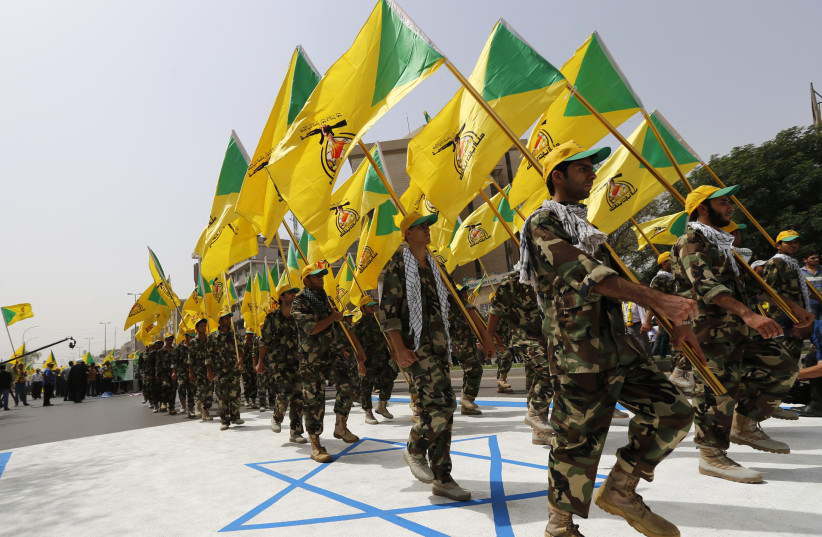Pro-Iranian militias in Iraq may want to transfer weapons and threats closer to the border with Israel.
By Seth Frantzman, JPOST SEPTEMBER 14, 2021
Iraqi Shi’ite Muslim men from the Iranian-backed group Kataib Hezbollah wave the party’s flags as they walk along a street painted in the colours of the Israeli flag during a parade marking the annual Quds Day, or Jerusalem Day, on the last Friday of the Muslim holy month of Ramadan, in Baghdad
Pro-Iranian militias have increasingly used drones to target US forces. In the last week they allegedly flew a drone toward Erbil International Airport to target US forces in the Kurdistan region of Iraq. Could those militias in Iraq now be working more closely with Palestinians? In an article at the pro-Iranian site Al-Mayadeen, hints of closer cooperation emerged this week.
Why does this matter? In May, an Iranian drone was flown from Iraq or Syria into Israeli airspace and shot down. Israel’s Defense Minister Benny Gantz warned about Iran training proxy forces with drones in Iran this week. Hamas also used new Iranian-style kamikaze drones in May.
Gantz warned on September 12 at the annual International Institute for Counter-Terrorism (ICT) Conference at Reichman University that “Iran has developed ‘proxy terror’ which is perpetrated by organized ‘terror armies’ which are assisting Iran in achieving its economic, political and military goals. One of the most significant tools employed by Iran and its proxies is UAVs with a range of thousands of kilometers. Hundreds of these UAVs are spread across Yemen, Iraq, Syria and Lebanon. Iran is also attempting to transfer the know-how needed for UAV production to Gaza.”
He said that the Kashan base in Iran is used to train terrorists from Yemen, Iraq, Syria snd Lebanon. These terrorists are trained to employ UAVs produced by Iran. This base is a key point from which Iranian aerial terrorism is exported to the region.”
The article postulates that the “growing strength of the resistance factions in Iraq after the defeat of ‘ISIS’, and their role in supporting and strengthening the issues of the region, foremost of which is the Palestinian cause , made the American feel ‘a state of anxiety’, demonstrated by the American statements ‘supporting Israel’s strength in the region’ and the American and Israeli strikes on the sites of these factions.”
This sentence hints at a larger context. Back in 2019, the pro-Iranian militias accused Israel of airstrikes in Iraq. In the fall of 2017, Qais Khazali of the Asaib Ahl al-Haq militia in Iraq visited Lebanon to say he would support Hezbollah in a war with Israel. In the summer of 2018, an airstrike targeted a Kataib Hezbollah headquarters in Albukamal in Syria near the Iraqi border. This was allegedly part of Iran’s path to the sea, a corridor of pro-Iranian groups stretching from Baghdad via Albukamal to Damascus and Lebanon.
Now Al-Mayadeen says that pro-Iranian groups in Iraq have been increasing their rhetorical support for Palestinians, especially for Hamas. Iran backs Hamas and also Palestinian Islamic Jihad. Iran also backs the Iraqi militias via the IRGC Quds Force. The US killed Qasem Soleimani, head fo the Quds Force, in January 2020. The Al-Nujaba movement is quoted in the article as say “the hands of the Iraqi resistance reach deep into the occupied Palestinian territories.”
The article says other factions also support the Palestinians, the Fatah Alliance in parliament, of which Badr Organization is a key part, and also Kataib Hezbollah. Kataib Hezbollah leader Abu Mahdi al-MUhandis was killed by the US in the same airstrike that killed Soleimani in 2020.
What matters here is more the messaging than the facts on the ground. The militias may want to transfer weapons and threats closer to the Golan border, as Hezbollah did with a drone team in the fall of 2019. In February 2018 Iran also flew a drone from T-4 base into Israeli airspace. It was shot down near Beit Shean. The goal of Iran is to slowly lay the groundwork for more cooperation and use these groups as a conduit for weapons. In August 2018 and November 2019, reports emerged that Iran had moved ballistic missiles to Iraq to be housed in warehouses used by these groups. The new drone attacks on US forces in places like Erbil, and threats by pro-Iran militias near Deir Ezzor to US forces at Omar oil field and other locations in eastern Syria, is part of this web of threats.
Iran has also bragged about its support for Houthis in Yemen who have achieved long range ballistic missile and drone capabilities. They have used drones and missiles to target Aramco and other energy facilities in Saudi Arabia. Iran also used a drone to target the Mercer Street in late July. The Houthis may be basing Iranian drones capable of threatening Israel as well.




Leave a Reply
You must be logged in to post a comment.